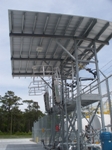
New System Offers Access and Safety
A refueling system installed at the Marine Corps' Camp Lejeune used aluminum safety enclosures to provide fall protection for operators during refueling and adjustable chain stops for extra sturdiness.
- By Doug Ingram
- Apr 01, 2011
Oscar W. Larson Company, headquartered in Clarkson, Mich., has served as a fluid handling and equipment contractor for the petroleum distribution industry for more than half a century. Its customers are involved in automotive, commercial, government, military, and other applications. When O.W. Larson was tasked with building a refueling system for military vehicles and tanker trucks at Camp Lejeune, a Marine Corps Base in North Carolina, it was the first time the company had needed to build a loading rack for its system design. The rack would be used to provide sufficient, safe operator access to vehicles during the refueling process, and a standard model wouldn't suffice.
"We needed loading racks with a broad range of flexibility, as they would be used for filling vehicles of different sizes," said Darren Painter, a project manager at the company. O.W. Larson selected five loading racks with multiple operator access options, such as safety stairs and bridges. The loading racks were customized in size and featured a variety of canopy styles to meet specific application requirements at Camp Lejeune.
Because each loading rack is designed for the geographical zone in which it is located -- some even have been specified for hurricane-prone areas or areas susceptible to high winds -- this customer-specified construction ensures the access equipment can withstand up to a decade of frequent use. Structural platforms and canopies offer extended durability that often lasts several decades.
Some racks included canopies incorporated into their design, which are used to protect operators from rain, snow, or sun during the refueling process. They also help to protect the integrity of the gasoline, diesel, and JP-8 fuel used by the operators to fill the vehicles, by keeping unwanted moisture from entering the tanks. These canopies are often customized to pass building codes or extended to accommodate larger vehicles, as was needed with the Camp Lejeune project. "In this application, we were dealing with larger-than-normal military vehicles and taller-than-standard tanker trucks. It was a custom project from the onset," Painter said.
To meet these strict requirements, the canopies needed to be extended without extending the structural platforms beneath them. Additionally, the racks were designed to be about 10 feet high to accommodate the larger vehicles.
O.W. Larson also used aluminum safety enclosures, which provide fall protection for operators during refueling, and adjustable chain stops that make the rack's gangway self supporting, thus providing extra sturdiness. This refueling system additionally incorporated aluminum self-leveling stairs that offer both stability and convenience, as is demonstrated in vehicle spotting.
Some of the trucks refueled at this base are 9 or 10 feet tall, while others, such as isotainers, carry tanks that are 13 feet high. If the trucks are misspotted, the operator will be unable to reach them without taking the time to reposition the truck, which is both inconvenient and time consuming. But the safety stairs O.W. Larson selected are on a pivot mount, so they can be moved 15 degrees left or right, making the system more forgiving of misspotting and saving operator time and hassle.
O.W. Larson installed the five loading racks on site without vendor assistance beyond the detailed installation instructions provided by the manufacturer. Painter said it was the combination of customization and simple installation that made the loading racks the right selection for the Camp Lejeune project. "The biggest benefit for us was that, instead of a cookie-cutter solution, we got something that exactly met our needs," he said.
This article originally appeared in the April 2011 issue of Occupational Health & Safety.
About the Author
Doug Ingram is general manager of Green Access & Fall Protection for Benko Products Inc. (www.benkoproducts.com) of Sheffield Village, Ohio.